During
the health care pandemic and beginning in March 2020, the Centers for Medicare
& Medicaid Services (CMS) suspended the regular survey process and announced
its plan to conduct limited surveys that focused on infection prevention and
control issues.[1]
CMS has publicly reported the results of these limited services each month
through a link on its website Nursing
Home Compare (now Care
Compare[2]).
The Center for Medicare Advocacy has analyzed these survey reports monthly and
reported our findings in a series of CMA
Alerts and Reports.
In
August, CMS encouraged states to resume conducting standard (annual) and
complaint surveys, to the extent possible,[3] and is now reporting these survey findings
through the same link on its public website. The CMS report describes the
cumulative infection control deficiencies (F-880) that have been cited
following infection control surveys, annual surveys, and complaint surveys
since March. While an increasing number of infection control deficiencies
are cited, most deficiencies continue to be classified as not causing residents
any harm.
November 2020 Data
Although
CMS has generally posted data on the last Wednesday of each month, it posted
its seventh cumulative data release on November 18, reflecting deficiencies
cited from March through October, as reported by state survey agencies to
CMS. The cumulative data release for November includes, for the first
time, deficiencies that were cited in much earlier months. For example,
the July data release (covering deficiencies reported through June) indicated
that 347 infection control deficiencies had been cited; the November data
release (as reported below and covering deficiencies reported through October)
indicates that 972 infection deficiencies were cited, as of June.
According
to the November release, 4052 facilities have been cited with at least one
infection control deficiency since March. A considerably higher
percentage of surveys (nearly 10 percent) cited infection control deficiencies,
but a lower percentage (6.38 percent) of the deficiencies were cited as
immediate jeopardy, compared to the October cumulative release.
|
Date of CMS release
|
Total number of
surveys reported |
Total number (percent)
of infection control deficiencies cited |
Total number (percent)
of immediate jeopardy deficiencies cited |
|
June 4 |
5,724 |
163
(2.8%) |
1
(1.0%) |
|
June 24 |
9,899 |
262
(2.6%) |
4
(1.5%) |
|
July 29 |
16,987 |
347
(2.0%) |
22 (6.6%) |
|
August 26 |
25,593 |
556
(2.2%) |
48 (8.6%) |
|
September 30 |
32,681 |
777
(2.4%) |
75 (9.7%) |
|
October 28 |
40,144 |
1,104 (2.8%) |
112 (10.1%) |
|
November 18 |
52,680* |
4,918 (9.34%) |
314 (6.38%) |
*A
total of 61,820 surveys were conducted but more than 9,000 were duplicates (for
example, some surveys were coded as both complaint and infection control) so
that only 52,680 distinct surveys were actually conducted. The 61,820
duplicated surveys included 37,772 focused infection control surveys, 873
standard surveys, and 23,175 complaint surveys.
Infection Control Deficiencies, National Data
These
52,680 unduplicated surveys cited a total of 4918 infection control
deficiencies at 4052 nursing facilities.
Focused
infection control surveys cited the largest number of infection control
deficiencies.
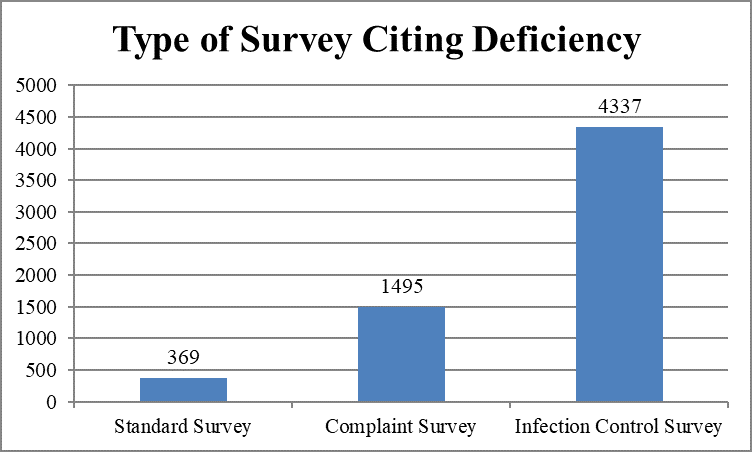
As
shown below, most infection control deficiencies (4580, 93 percent) were
classified as “no actual harm, with the potential for minimal harm” (“no harm”)
– categories D, E, and F.
Scope and Severity of Deficiencies
Cited, Cumulative
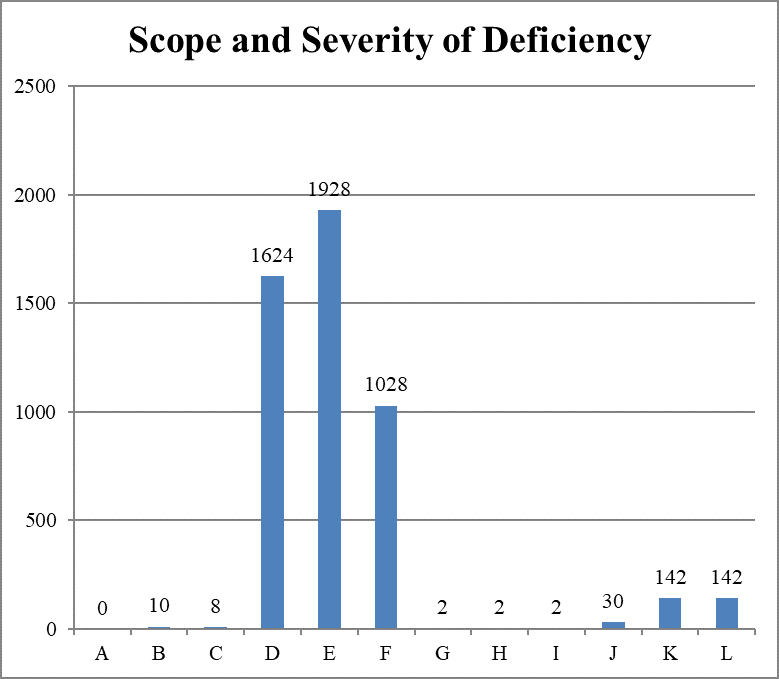
The
seventh cumulative report documents a large increase in infection control
deficiencies. However, most of them (4580, 93 percent) were classified as
no harm; only 314 of these deficiencies (6.38 percent) were classified as
immediate jeopardy.
Deficiencies Cited, by Monthly
Cumulative Report
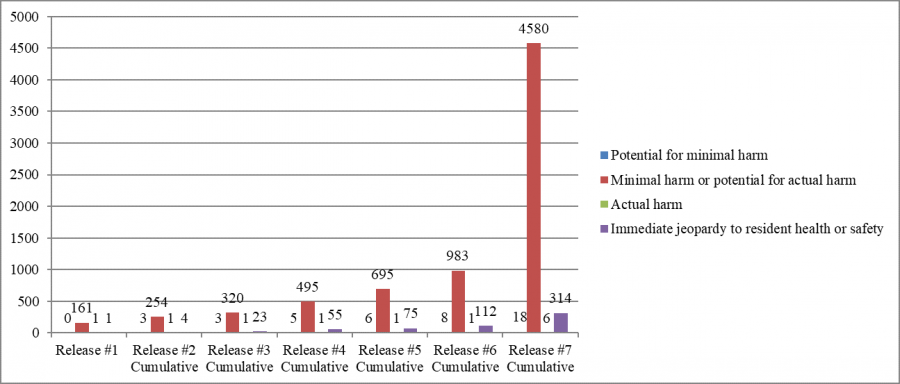
Scope and Severity, Cumulatively,
by Release Number
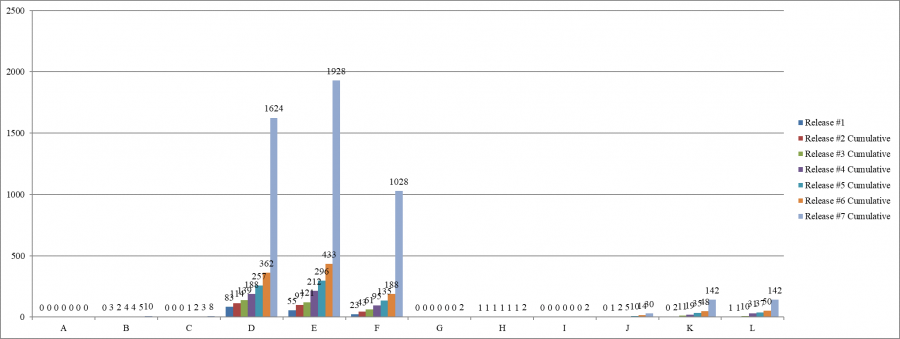
The
largest number
of infection control deficiencies
was cited in June, 972 deficiencies; the smallest number, in March, 322
deficiencies.
Infection Control Deficiencies, by
Month

However,
the largest number
of immediate jeopardy deficiencies
was cited in May, 64; the smallest number, in March, seven.
Immediate Jeopardy Infection
Control Deficiencies, by Month

The
largest percentage
of deficiencies classified as immediate
jeopardy was cited in May, 9.77 percent; the smallest
percentage, in March, 2.17 percent.

Infection Control Deficiencies, State Data
The
November data release, for the first time, reports that every state cited at
least one infection control deficiency since March.
The
seventh cumulative data release indicates that California has cited the largest
number of infection control deficiencies
– 502. Until this data release, Texas had been reported to have cited the
largest number of infection control deficiencies.
Cumulative Infection Control
Deficiencies by State

However,
the percentage
of infection control deficiencies cited as immediate jeopardy by each state ranged
from zero percent in 11 states (Alaska, Hawaii, Kentucky, Massachusetts, New
Hampshire, North Dakota, South Dakota, Tennessee, Vermont, West Virginia, and
Wyoming), Puerto Rico, and the District of Columbia to 20.53 percent
(Michigan).
Percent of Infection Control Cited
as Immediate Jeopardy, by State
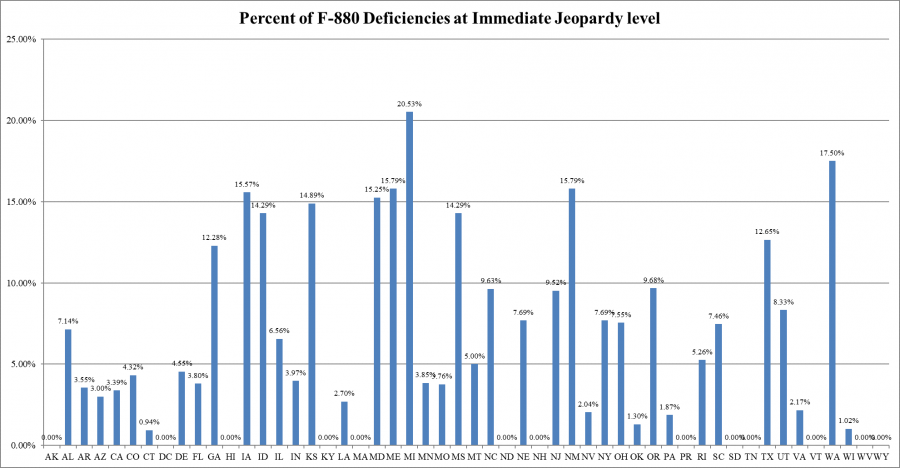
States
cited various numbers
of facilities with
infection control deficiencies. California cited the largest number of
facilities (395), while Vermont cited one. (California has more than 1200
nursing facilities; Vermont, 38 nursing facilities.)

Four
thousand fifty-two (4052) facilities were cited with an infection control
deficiency. Most facilities (3334 facilities) were cited with a single
infection control deficiency; 596 facilities were cited with two infection
control deficiencies; 103 facilities were cited with three infection control
deficiencies; 14 facilities were cited with four infection control
deficiencies; four facilities were cited with five infection control
deficiencies; and one facility was cited with seven infection control deficiencies.
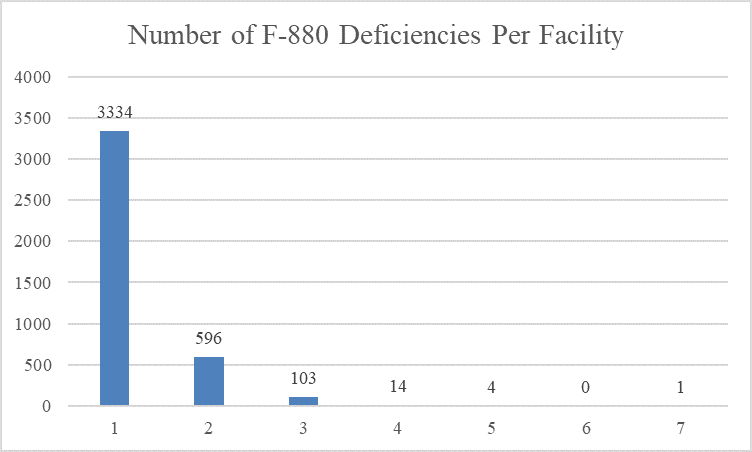
Conclusion
For
the first time, all states cited at least one infection control
deficiency. Eleven states have not cited any immediate jeopardy
deficiencies in infection control. Nonetheless, as throughout the
pandemic, most deficiencies have been classified as “no harm.”
__________________
[1] CMS, “Suspension of
Survey Activities,” QSO-20-12-All (Mar. 4, 2020), https://www.cms.gov/files/document/qso-20-12-all.pdf;
CMS, ‘Prioritization of Survey Activities,” QSO-20-20-All (Mar. 23, 2020), https://www.cms.gov/files/document/qso-20-20-all.pdf
[2] Center for Medicare Advocacy, “CMS Replaces
all Eight Care-Specific Websites with Single Website: Care Compare” (CMA Alert,
Dec. 10, 2020), https://medicareadvocacy.org/cms-replaces-all-eight-care-specific-websites-with-single-website-care-compare/
[3] CMS, “Enforcement Cases Held during the
Prioritization Period and Revised Survey Prioritization,” QSO-20-35-ALL (Aug.
17, 2020), https://www.cms.gov/files/document/qso-20-35-all.pdf
No comments:
Post a Comment